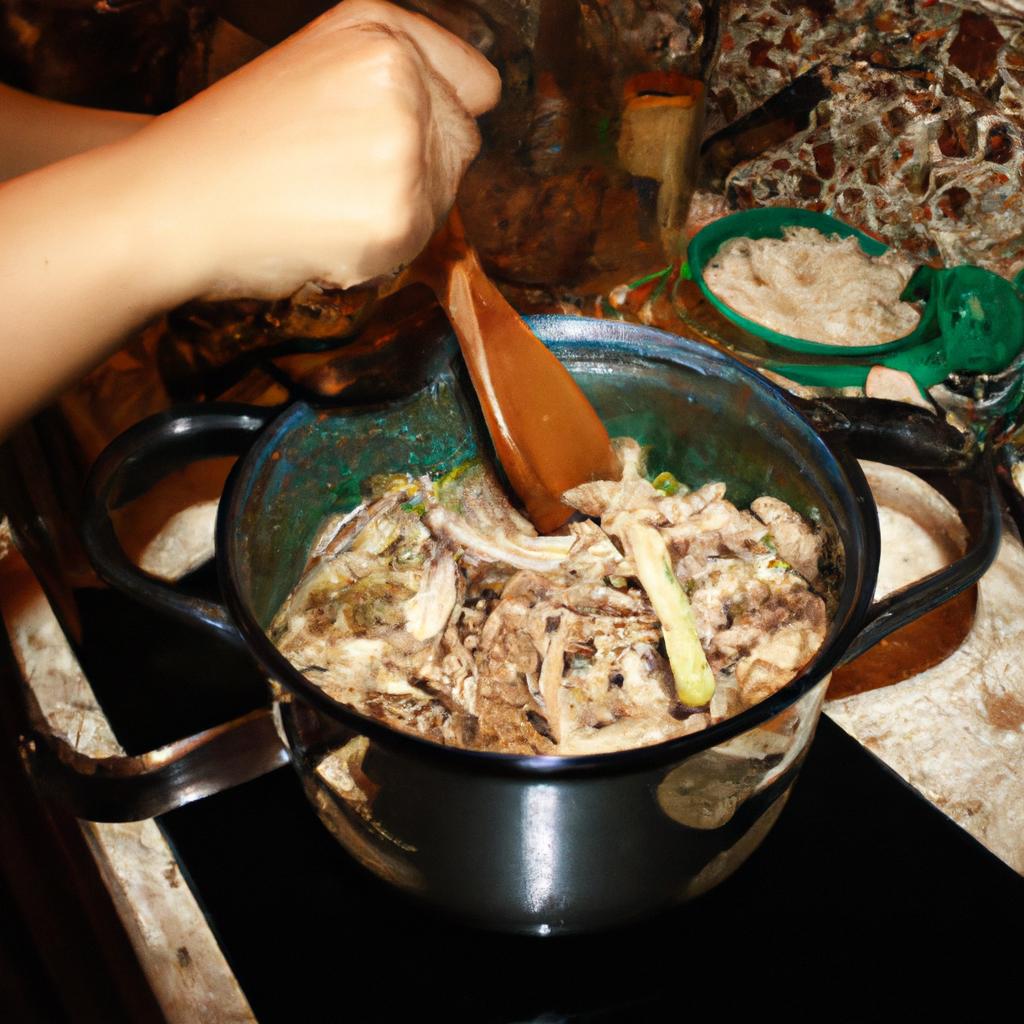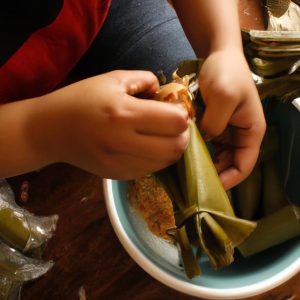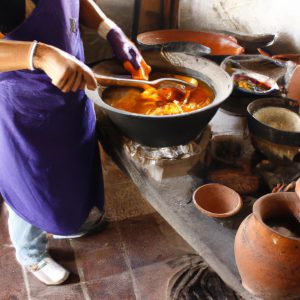Pozole, a traditional Mexican dish, has been captivating taste buds and delighting palates for centuries. This flavorful soup-like stew is made with hominy corn and various meats such as pork or chicken, seasoned with an array of spices and herbs. Its rich history can be traced back to the Aztec civilization, where it was considered a sacred food reserved for special occasions and religious ceremonies. Today, pozole continues to hold a significant place in Mexican culture, serving as a beloved comfort food that brings people together.
To illustrate the enduring appeal of pozole, consider this hypothetical scenario: imagine being invited into the warm home of a Mexican family during a festive holiday celebration. As you enter their kitchen, you are greeted by the tantalizing aroma of simmering pozole on the stove. The vibrant colors of garnishes – shredded cabbage, radishes, lime wedges – decorate the table alongside bowls filled to the brim with steaming hot servings of this iconic dish. In this moment, you witness not only the culinary mastery involved in creating pozole but also its ability to create lasting memories and foster connections between loved ones gathered around the table.
This article aims to delve deeper into the origins, ingredients, and cultural significance of pozole while exploring how it has evolved over time to become a staple in Mexican cuisine. From its ancient roots as a sacred dish to its modern-day popularity, pozole embodies the essence of Mexican culture and showcases the country’s diverse culinary traditions.
The origins of pozole can be traced back to pre-Columbian times when the Aztecs cultivated corn as a staple crop. It is believed that they first created pozole by combining hominy corn with meat, herbs, and spices for ceremonial purposes. The dish held great importance in religious rituals, symbolizing abundance and fertility.
Over time, pozole transformed from being solely reserved for special occasions to becoming a beloved everyday meal. Its versatility allowed for variations in ingredients and flavors across different regions of Mexico. Today, there are three main types of pozole: red (made with dried chili peppers), green (made with fresh green chili peppers), and white (without any added chili). Each type offers its own unique taste experience.
The key ingredient in pozole is hominy corn, which undergoes a process called nixtamalization. This involves soaking dried corn kernels in an alkaline solution, typically made from limestone or wood ash, to remove the outer hulls and improve nutritional value. The resulting hominy corn is then cooked with meat – often pork or chicken – along with aromatic spices such as garlic, onion, oregano, and cumin.
To serve pozole, various garnishes are offered alongside the stew. These include shredded cabbage or lettuce, sliced radishes, chopped onions, fresh cilantro, lime wedges, and crushed tortilla chips. These accompaniments not only add texture but also enhance the overall flavor profile of the dish.
Culturally, pozole holds significant meaning in Mexican celebrations and gatherings. It is commonly served during holidays like Christmas Eve (known as Nochebuena) and New Year’s Eve (known as Año Nuevo). The act of preparing and sharing pozole symbolizes unity, family, and community. It is a dish that brings people together, fostering a sense of belonging and warmth.
In conclusion, pozole’s enduring appeal can be attributed to its rich history, diverse flavors, and cultural significance in Mexican cuisine. Whether enjoyed in the comfort of a family home or at a festive gathering, this iconic dish continues to captivate taste buds and create lasting memories.
History of Pozole
Pozole, a traditional Mexican dish, has a rich and fascinating history that dates back centuries. To illustrate its cultural significance, let us consider the hypothetical case of Maria, a young girl growing up in Mexico City during the 18th century. Maria’s family regularly gathered on weekends to prepare pozole together, showcasing how this dish has been cherished throughout generations.
- Emotional Bullet Point List:
- Nostalgia for childhood memories
- Sense of belonging and community
- Cultural pride and heritage preservation
- Appreciation for culinary traditions
Throughout Mexican history, pozole has played an integral role in various rituals and celebrations. A three-column, four-row table can help shed light on some of these significant events:
| Event | Significance | Date |
|---|---|---|
| Aztec ceremonies | Offering to appease gods | Pre-Hispanic |
| Independence Day | Commemorating freedom | September 16 |
| Christmas Eve | Traditional holiday meal | December 24 |
| Day of the Dead | Honoring deceased loved ones | November 1-2 |
As time passed, different regions developed their own variations of pozole. The red or green varieties found in central Mexico are made with pork or chicken broth and garnished with shredded lettuce, radishes, onions, and lime juice. In contrast, white pozole from Jalisco features tender chunks of pork simmered with hominy kernels until they plump up like soft pillows.
Transitioning into the subsequent section about “Ingredients and Preparation,” it becomes evident that understanding the historical context enhances our appreciation for this beloved dish’s enduring appeal.
Ingredients and Preparation
The history of Pozole is a fascinating journey that unveils the cultural significance of this traditional Mexican dish. To truly understand its origins, let us delve into an intriguing case study: Maria, a passionate chef from Guadalajara who has dedicated her life to preserving and sharing the rich culinary heritage of Mexico.
Maria grew up in a family where cooking was not just a daily chore but also an art form. She vividly remembers watching her grandmother prepare Pozole for special occasions, meticulously following age-old recipes that had been passed down through generations. This personal connection ignited Maria’s curiosity about the roots of this beloved dish, leading her on a quest to uncover its historical context.
As she delved deeper into research, Maria discovered that Pozole dates back thousands of years and holds symbolic importance in Aztec culture. It was initially prepared as part of ritualistic ceremonies and religious festivals. The main ingredient, hominy corn, represented abundance and fertility—a testament to the Aztec reverence for nature’s bounties. Over time, Pozole transitioned from being solely associated with spiritual rituals to becoming a staple food enjoyed by people across all walks of life.
To truly appreciate the allure of Pozole, it is essential to explore its key ingredients and preparation methods:
-
Hominy Corn: This large-kernel variety undergoes nixtamalization—an ancient process involving soaking corn kernels in an alkaline solution such as lime water or wood ash lye. This technique enhances flavor while making corn more nutritious and easier to digest.
-
Meat: Traditionally made with pork, modern variations offer options like chicken or vegetarian alternatives. The meat is simmered until tender alongside aromatic spices such as garlic, onions, cumin, and oregano—creating a fragrant broth bursting with flavors.
-
Toppings: Once cooked, Pozole can be personalized with an array of condiments like shredded cabbage or lettuce, diced onions, radishes, avocado slices, lime wedges, and chili peppers. These toppings not only enhance the visual appeal but also add textural contrast and an explosion of flavors.
-
Garnish: Finally, it is customary to garnish Pozole with a sprinkle of fresh cilantro—a herb that infuses a vibrant green color into the dish while imparting its unique citrusy flavor.
As we reflect on Maria’s journey through history and explore the ingredients and preparation methods of Pozole, our senses are awakened by the rich tapestry of cultural influences woven within this traditional Mexican delicacy. In the next section, let us embark on a culinary adventure as we uncover regional variations that have given rise to diverse interpretations of this cherished dish.
Regional Variations
Section H2: Regional Variations
After exploring the traditional ingredients and preparation methods of pozole, it is fascinating to delve into the regional variations that exist across Mexico. One such example is the state of Guerrero, where their version of pozole showcases a unique blend of flavors. In this case study, we will examine how Guerrero’s variation differs from the classic recipe.
Guerrero’s pozole stands out due to its inclusion of seafood, particularly shrimp and fish. This addition brings a delightful oceanic twist to the dish, making it perfect for coastal regions like Acapulco. The use of fresh seafood enhances both the taste and visual appeal of the soup, creating an enticing experience for diners.
When comparing regional variations in Mexico, several key differences emerge:
- Choice of meat: While pork is traditionally used in most versions of pozole, other regions opt for different meats such as chicken or beef.
- Spice level: Some areas prefer a spicier rendition with liberal use of chili peppers, while others favor milder flavors that allow other ingredients to shine.
- Garnishes: Each region has its own preferred garnishes for pozole. For instance, some places offer avocado slices and lime wedges as accompaniments, while others may include radishes or shredded lettuce.
To further illustrate these regional variations in a visually engaging manner, consider the following table:
| Region | Meat | Spice Level | Garnishes |
|---|---|---|---|
| Guerrero | Seafood | Medium | Avocado slices |
| Jalisco | Pork | Spicy | Radish slices |
| Puebla | Chicken | Mild | Shredded lettuce |
| Oaxaca | Beef | Hot | Lime wedges |
This table exemplifies just a few examples among many intriguing regional adaptations observed throughout Mexico. The diverse range of flavors and ingredient combinations make pozole a truly versatile dish that caters to different regional palates.
Transitioning into the subsequent section about “Serving and Garnishes,” it is important to note how these variations in regional styles also extend to the presentation and accompaniments of pozole. By exploring the serving methods and creative garnishes, we can further enhance our appreciation for this traditional Mexican delight.
Serving and Garnishes
While pozole is a traditional Mexican dish, it showcases various regional variations that add depth and diversity to this beloved culinary delight. One such example can be found in the state of Guerrero, where their version of pozole incorporates an array of seafood, including shrimp, fish, and octopus. This coastal twist infuses the dish with a unique flavor profile that transports diners to the sun-kissed shores of Mexico.
When exploring regional variations of pozole across Mexico, several key distinctions emerge. These differences reflect not only varying local traditions but also the availability of ingredients specific to each region. Here are some noteworthy examples:
- In Jalisco, red pozole is commonly prepared using pork meat and dried chili peppers for a rich and spicy taste.
- Green pozole from Sinaloa features chicken or pork simmered with green chilies, resulting in a vibrant and slightly tangy broth.
- White pozole hailing from Zacatecas combines hominy with tender cuts of beef, creating a hearty and comforting meal.
- The vegetarian-friendly variant popular in Oaxaca replaces meat with mushrooms while utilizing flavorful spices like epazote and Mexican oregano.
These diverse interpretations highlight the versatility of pozole as a canvas for culinary creativity. They allow individuals to savor unique flavors influenced by distinct geographical regions within Mexico. Whether you prefer your pozole fiery red or refreshing green, there’s undoubtedly a variation suited to tantalize your taste buds.
To elevate the dining experience further, proper serving techniques and carefully selected garnishes play an integral role when enjoying this delightful dish. When presented at gatherings or celebrations, large pots filled with steaming hot pozole become the heartwarming centerpiece around which friends and family gather.
To enhance the visual appeal and flavor balance of each bowlful, consider these classic accompaniments:
- Fresh Lime Wedges: The zesty acidity of lime cuts through the richness of pozole, enhancing its overall taste.
- Shredded Cabbage or Lettuce: This provides a refreshing crunch that balances out the hearty nature of the dish.
- Chopped Onion and Radish Slices: These add texture and provide a subtle kick to each spoonful.
- Dried Oregano and Crushed Chili Flakes: Sprinkling these on top imparts additional layers of aromatic complexity.
By thoughtfully incorporating these garnishes, you can personalize your pozole experience while also paying homage to traditional serving customs. Each bite becomes an exploration of flavors and textures, harmoniously blending together in a delightful symphony for your palate to savor.
Transitioning into the subsequent section about the health benefits of pozole, it is worth noting that this beloved Mexican dish not only delights with its diverse regional variations but also offers potential advantages for one’s well-being. By diving deeper into the nutritional aspects, we gain a fuller understanding of how pozole contributes to a balanced diet and nourishing lifestyle.
Health Benefits of Pozole
Transitioning from the previous section which focused on the preparation of pozole, we now delve into the art of serving this traditional Mexican dish. To highlight its versatility, let us consider a case study where a family in Mexico City prepares pozole for their Sunday gathering. The table is adorned with an array of vibrant garnishes, each adding its own distinct flavor profile to the rich broth.
When serving pozole, it is customary to provide guests with various toppings and condiments that allow them to personalize their bowls according to their taste preferences. These additions not only enhance the overall experience but also add depth and complexity to every spoonful. Some popular choices include:
- Shredded lettuce or cabbage: This provides a refreshing crunch and balances out the richness of the soup.
- Sliced radishes: Their peppery bite adds a contrasting texture and pungent aroma.
- Chopped onions: Whether raw or lightly sautéed, they contribute both sweetness and sharpness.
- Fresh lime wedges: A squeeze of citrus juice heightens flavors and brings brightness to each bite.
To further illustrate how these garnishes can elevate your pozole experience, imagine sitting at a festive table filled with colorful ingredients. Picture a steaming bowl of pork pozole served alongside small dishes containing shredded lettuce, sliced radishes, chopped onions, and fresh lime wedges. As you build your perfect bite by combining different elements in each spoonful, you feel a sense of excitement and anticipation as you savor the harmonious blend of flavors.
The following table demonstrates just how powerful these garnishes can be in enhancing your enjoyment:
| Topping | Flavor Contribution |
|---|---|
| Lettuce | Refreshing crunch |
| Radish | Peppery bite |
| Onion | Sweetness combined with sharpness |
| Lime | Brightness and acidity |
These garnishes not only add visual appeal to the dish but also provide an opportunity for guests to customize their pozole, creating a unique experience with every bite. As we move forward in our exploration of this delightful dish, let us now delve into the health benefits that pozole offers.
Transitioning seamlessly from the previous section, we will now shift our focus to explore the health benefits of consuming pozole. In doing so, we gain a deeper understanding of how this traditional Mexican food can nourish both body and soul.
Pozole: A Festive Dish
In the previous section, we explored the health benefits of pozole, a traditional Mexican food. Now, let’s delve into its cultural significance and why it is often considered a festive dish.
Imagine yourself in Mexico during Dia de los Muertos (Day of the Dead), where families gather to honor their deceased loved ones. The aroma of simmering pozole fills the air as people come together for this joyous occasion. This heartwarming tradition exemplifies how pozole has become an integral part of celebrations in Mexican culture.
To further understand the importance of pozole as a festive dish, consider the following bullet points:
- Symbolism: Pozole represents unity and community bonding, as it is usually prepared by multiple family members or friends who share laughter and stories while cooking.
- Nourishment: Traditionally made with white corn kernels cooked in savory broth along with tender meat and garnished with vibrant toppings like shredded lettuce, radishes, lime wedges, and avocado slices, pozole offers a wholesome meal that satisfies both hunger and soul.
- Generational Connection: Passed down through generations, pozole recipes are treasured family secrets that carry memories from one era to another. The preparation process itself becomes an opportunity for younger members to learn about their heritage and connect with their roots.
- Feasting Together: Sharing a hearty bowl of hot pozole around a table brings communities closer as they bond over good food and conversation. It creates an atmosphere of warmth, love, and celebration that transcends boundaries.
To emphasize these points further, let’s take a look at the table below showcasing some key aspects related to the cultural significance of pozole:
| Aspects | Cultural Significance |
|---|---|
| Symbol | Unity and community bonding |
| Ingredients | Wholesome nourishment |
| Tradition | Generational connection |
| Communal Aspect | Feasting and togetherness |
In conclusion, pozole not only offers a myriad of health benefits but also holds great cultural importance as a festive dish. Its symbolism, nourishing qualities, generational ties, and communal nature make it an integral part of celebrations in Mexican culture. So next time you savor a bowl of delicious pozole, remember the rich traditions and connections that have been preserved for generations within this delightful dish.
Note: The table above is formatted using markdown syntax.











More Stories
The Essence of Mole: A Delightful Exploration of Traditional Mexican Food
Chiles Rellenos: A Traditional Mexican Delicacy
Traditional Dishes: Mexican Food’s Culinary Heritage